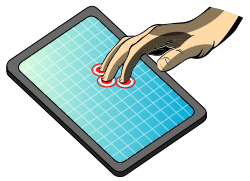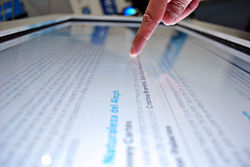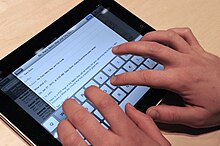Multi-touch


In
Several uses of the term multi-touch resulted from the quick developments in this field, and many companies using the term to market older technology which is called gesture-enhanced single-touch or several other terms by other companies and researchers. Several other similar or related terms attempt to differentiate between whether a device can exactly determine or only approximate the location of different points of contact to further differentiate between the various technological capabilities, but they are often used as synonyms in marketing.
Multi-touch is commonly implemented using
Definition
In computing, multi-touch is technology which enables a touchpad or touchscreen to recognize more than one[7][8] or more than two[9] points of contact with the surface.
The two different uses of the term resulted from the quick developments in this field, and many companies using the term to market older technology which is called gesture-enhanced single-touch or several other terms by other companies and researchers.[10][11] Several other similar or related terms attempt to differentiate between whether a device can exactly determine or only approximate the location of different points of contact to further differentiate between the various technological capabilities,[11] but they are often used as synonyms in marketing.
History
1960–2000
The use of
Exceptions to these were a "cross-wire" multi-touch reconfigurable touchscreen keyboard/display developed at the

In 1976 a new
In the early 1980s, The University of Toronto's Input Research Group were among the earliest to explore the software side of multi-touch input systems.[23] A 1982 system at the University of Toronto used a frosted-glass panel with a camera placed behind the glass. When a finger or several fingers pressed on the glass, the camera would detect the action as one or more black spots on an otherwise white background, allowing it to be registered as an input. Since the size of a dot was dependent on pressure (how hard the person was pressing on the glass), the system was somewhat pressure-sensitive as well.[12] Of note, this system was input only and not able to display graphics.
In 1983, Bell Labs at Murray Hill published a comprehensive discussion of touch-screen based interfaces, though it makes no mention of multiple fingers.[24] In the same year, the video-based Video Place/Video Desk system of Myron Krueger was influential in development of multi-touch gestures such as pinch-to-zoom, though this system had no touch interaction itself.[25][26]
By 1984, both Bell Labs and Carnegie Mellon University had working multi-touch-screen prototypes – both input and graphics – that could respond interactively in response to multiple finger inputs.[27][28] The Bell Labs system was based on capacitive coupling of fingers, whereas the CMU system was optical. In 1985, the canonical multitouch pinch-to-zoom gesture was demonstrated, with coordinated graphics, on CMU's system.[29][30] In October 1985, Steve Jobs signed a non-disclosure agreement to tour CMU's Sensor Frame multi-touch lab.[31] In 1990, Sears et al. published a review of academic research on single and multi-touch touchscreen human–computer interaction of the time, describing single touch gestures such as rotating knobs, swiping the screen to activate a switch (or a U-shaped gesture for a toggle switch), and touchscreen keyboards (including a study that showed that users could type at 25 words per minute for a touchscreen keyboard compared with 58 words per minute for a standard keyboard, with multi-touch hypothesized to improve data entry rate); multi-touch gestures such as selecting a range of a line, connecting objects, and a "tap-click" gesture to select while maintaining location with another finger are also described.[32]
In 1991, Pierre Wellner advanced the topic publishing about his multi-touch "Digital Desk", which supported multi-finger and pinching motions.[33][34] Various companies expanded upon these inventions in the beginning of the twenty-first century.
2000–present
Between 1999 and 2005, the company
In 2004, French start-up JazzMutant developed the
In January 2007, multi-touch technology became mainstream with the iPhone, and in its iPhone announcement Apple even stated it "invented multi touch",[41] however both the function and the term predate the announcement or patent requests, except for the area of capacitive mobile screens, which did not exist before Fingerworks/Apple's technology (Fingerworks filed patents in 2001–2005,[42] subsequent multi-touch refinements were patented by Apple[43]).
However, the U.S. Patent and Trademark office declared that the "pinch-to-zoom" functionality was predicted by U.S. Patent # 7,844,915
In 2001, Microsoft's table-top touch platform, Microsoft PixelSense (formerly Surface) started development, which interacts with both the user's touch and their electronic devices and became commercial on May 29, 2007. Similarly, in 2001, Mitsubishi Electric Research Laboratories (MERL) began development of a multi-touch, multi-user system called DiamondTouch.
In 2008, the Diamondtouch became a commercial product and is also based on capacitance, but able to differentiate between multiple simultaneous users or rather, the chairs in which each user is seated or the floorpad on which the user is standing. In 2007, NORTD labs
Small-scale touch devices rapidly became commonplace in 2008. The number of touch screen telephones was expected to increase from 200,000 shipped in 2006 to 21 million in 2012.[47]
In May 2015, Apple was granted a patent for a "fusion keyboard", which turns individual physical keys into multi-touch buttons.[48]
Applications

Multi-touch sensing and processing occurs via an
It is now common for laptop manufacturers to include multi-touch touchpads on their laptops, and tablet computers respond to touch input rather than traditional stylus input and it is supported by many recent operating systems.
A few companies are focusing on large-scale surface computing rather than personal electronics, either large multi-touch tables or wall surfaces. These systems are generally used by government organizations, museums, and companies as a means of information or exhibit display.[citation needed]
Implementations
Multi-touch has been implemented in several different ways, depending on the size and type of interface. The most popular form are mobile devices, tablets, touchtables and walls. Both touchtables and touch walls project an image through acrylic or glass, and then back-light the image with LEDs.
Touch surfaces can also be made pressure-sensitive by the addition of a pressure-sensitive coating that flexes differently depending on how firmly it is pressed, altering the reflection.[52]
Handheld technologies use a panel that carries an electrical charge. When a finger touches the screen, the touch disrupts the panel's electrical field. The disruption is registered as a computer event (gesture) and may be sent to the software, which may then initiate a response to the gesture event.[53]
In the past few years, several companies have released products that use multi-touch. In an attempt to make the expensive technology more accessible, hobbyists have also published methods of constructing
Capacitive
Capacitive technologies include:[55]
- Surface Capacitive Technology or Near Field Imaging (NFI)
- Projected Capacitive Touch(PCT)
- In-cell Capacitive
Resistive
Resistive technologies include:[55]
- Analog Resistive
- Digital Resistive or In-Cell Resistive
Optical
Optical touch technology is based on image sensor technology. It functions when a finger or an object touches the surface, causing the light to scatter, the reflection of which is caught with sensors or cameras that send the data to software that dictates response to the touch, depending on the type of reflection measured.
Optical technologies include:[55]
- Infrared technology
- Rear Diffused Illumination (DI)[56]
- Infrared Grid Technology (opto-matrix) or Digital Waveguide Touch (DWT) or Infrared Optical Waveguide
- Frustrated Total Internal Reflection(FTIR)
- Diffused Surface Illumination (DSI)
- Laser Light Plane (LLP)
- In-Cell Optical
Wave
Acoustic and radio-frequency wave-based technologies include:[55]
- Surface Acoustic Wave (SAW)
- Bending Wave Touch (BWT)
- Dispersive Signal Touch (DST)
- Acoustic Pulse Recognition (APR)
- Force-Sensing Touch Technology
Multi-touch gestures
Multi-touch touchscreen gestures enable predefined motions to interact with the device and software. An increasing number of devices like smartphones, tablet computers, laptops or desktop computers have functions that are triggered by multi-touch gestures.
Popular culture
Before 2007
Years before it was a viable consumer product, popular culture portrayed potential uses of multi-touch technology in the future, including in several installments of the Star Trek franchise.
In the 1982 Disney
In the 2002 film Minority Report, Tom Cruise uses a set of gloves that resemble a multi-touch interface to browse through information.[57]
In the 2005 film The Island, another form of a multi-touch computer was seen where the professor, played by Sean Bean, has a multi-touch desktop to organize files, based on an early version of Microsoft Surface[2] (not be confused with the tablet computers which now bear that name).
In 2007, the television series CSI: Miami introduced both surface and wall multi-touch displays in its sixth season.
After 2007
Multi-touch technology can be seen in the 2008
In the 2008 film The Day the Earth Stood Still, Microsoft's Surface was used.[59]
The television series NCIS: Los Angeles, which premiered 2009, makes use of multi-touch surfaces and wall panels as an initiative to go digital.
In a 2008, an episode of the television series The Simpsons, Lisa Simpson travels to the underwater headquarters of Mapple to visit Steve Mobbs, who is shown to be performing multiple multi-touch hand gestures on a large touch wall.
In the 2009, the film District 9 the interface used to control the alien ship features similar technology.[60]
10/GUI
10/GUI is a proposed new user interface paradigm. Created in 2009 by R. Clayton Miller, it combines multi-touch input with a new windowing manager.
It splits the touch surface away from the screen, so that user fatigue is reduced and the users' hands don't obstruct the display.[61] Instead of placing windows all over the screen, the windowing manager, Con10uum, uses a linear paradigm, with multi-touch used to navigate between and arrange the windows.[62] An area at the right side of the touch screen brings up a global context menu, and a similar strip at the left side brings up application-specific menus.
An open source community preview of the Con10uum window manager was made available in November, 2009.[63]
See also
- Gesture-enhanced single-touch
- Lemur Input Device
- Gesture recognition
- Human–computer interaction
- Natural user interface
- Pen computing
- Reactable
- Sensacell
- Sketch recognition
- Surface Computing
- Tenori-on
- Touchpad
- Touch user interface
References
- ^ a b Stumpe, Bent (16 March 1977), A new principle for x-y touch system (PDF), CERN, retrieved 2010-05-25
- ^ "Multi-Touch Technology and the Museum: An Introduction". AMT Lab @ CMU. 18 October 2015. Retrieved 2020-11-06.
- ^ Crowley-Milling, Michael (29 September 1977). New Scientist. Reed Business Information. pp. 790–791.
- ISSN 1793-1339.
- ISBN 9781927500057.
- ^ Ganapati, Priya (5 March 2010). "Finger Fail: Why Most Touchscreens Miss the Point". Wired. Archived from the original on 11 May 2014. Retrieved 9 November 2019.
- ^ "Multi-touch definition of Multi-touch in the Free Online Encyclopedia". encyclopedia2.thefreedictionary.com. Retrieved 2014-11-23.
- ^ "Glossary - X2 Computing". x2computing.com. Archived from the original on 2014-08-17. Retrieved 2014-11-23.
- ISBN 9780980868906. Retrieved 2014-11-23.
- S2CID 40545665.
- ^ a b "What is Multitouch". Retrieved 2010-05-30.
- ^ a b Buxton, Bill. "Multitouch Overview"
- ^ "Multi-Touch Technology, Applications and Global Markets". www.prnewswire.com (Press release). Retrieved 2015-11-16.
- ^ S2CID 16749393.
- . CERN-73-06. Retrieved 2020-01-28.
- ^ The first capacitative touch screens at CERN, CERN Courrier, 31 March 2010, retrieved 2010-05-25
- ^ Stumpe, Bent (6 February 1978), Experiments to find a manufacturing process for an x-y touch screen (PDF), CERN, retrieved 2010-05-25
- ^ Petersen, Peter (1983). Man-machine communication (Bachelor). Aalborg University.
- ISBN 978-1-4735-4254-9.
- ^ Henriksen, Benjamin; Munch Christensen, Jesper; Stumpe, Jonas (2012). The evolution of CERN's capacitive touchscreen (PDF) (Bachelor). University of Copenhagen.
- ^ Stumpe, Bent; Sutton, Christine (1 June 2010). "CERN touch screen". Symmetry Magazine. A joint Fermilab/SLAC publication. Archived from the original on 16 November 2016. Retrieved 16 November 2016.
- ^ "Data processing". CERN Courier. 14 (4): 116–17. 1974.
- ^ Mehta, Nimish (1982), A Flexible Machine Interface, M.A.Sc. Thesis, Department of Electrical Engineering, University of Toronto supervised by Professor K.C. Smith.
- )
- ^ Krueger, Myron. "Videoplace '88". YouTube. Archived from the original on 2021-12-14.
- ^ Krueger, Myron, W., Gionfriddo, Thomas., &Hinrichsen, Katrin (1985). VIDEOPLACE - An Artificial Reality, Proceedings of the ACM Conference on Human Factors in Computing Systems (CHI’85), 35–40.
- ^ Dannenberg, R.B., McAvinney, P. and Thomas, M.T. Carnegie-Mellon University Studio Report. In Proceedings of the International Computer Music Conference (Paris, France, October 19–23, 1984). ICMI. pp. 281-286.
- ^ McAvinney, P. The Sensor Frame - A Gesture-Based Device for the Manipulation of Graphic Objects. Carnegie Mellon University, 1986.
- ^ TEDx Talks (2014-06-15), Future of human/computer interface: Paul McAvinney at TEDxGreenville 2014, archived from the original on 2021-12-14, retrieved 2017-02-24
- S2CID 1196331.
- ^ O'Connell, Kevin. "The Untold History of MultiTouch" (PDF). pp. 14–17. Retrieved 2018-07-15.
- ^ Sears, A., Plaisant, C., Shneiderman, B. (June 1990) A new era for high-precision touchscreens. Advances in Human-Computer Interaction, vol. 3, Hartson, R. & Hix, D. Eds., Ablex (1992) 1-33 HCIL-90-01, CS-TR-2487, CAR-TR-506. [1]
- YouTube
- ^ Pierre Wellner's papers Archived 2012-07-18 at the Wayback Machine via DBLP
- ^ Westerman, W., Elias J.G. and A.Hedge (2001) Multi-touch: a new tactile 2-d gesture interface for human-computer interaction Proceedings of the Human Factors and Ergonomics Society 45th Annual Meeting, Vol. 1, 632-636.
- ^ Shanis, J. and Hedge, A. (2003) Comparison of mouse, touchpad and multitouch input technologies. Proceedings of the Human Factors and Ergonomics Society 47th Annual Meeting, Oct. 13–17, Denver, CO, 746-750.
- ^ Thom-Santelli, J. and Hedge, A. (2005) Effects of a multitouch keyboard on wrist posture, typing performance and comfort. Proceedings of the Human Factors and Ergonomics Society 49th Annual Meeting, Orlando, Sept. 26-30, HFES, Santa Monica, 646-650.
- ^ Heisler, Yoni (June 25, 2013). "Apple's most important acquisitions". Network World.
- ^ Buxton, Bill. "Multi-Touch Systems that I Have Known and Loved". billbuxton.com/.
- ^ Guillaume, Largillier. "Developing the First Commercial Product that Uses Multi-Touch Technology". informationdisplay.org/. SID Information Display Magazine. Retrieved 26 January 2018.
- ^ Steve Jobs (2006). "And Boy Have We Patented It". Retrieved 2010-05-14.
And we have invented a new technology called Multi-touch
- ^ "US patent 7,046,230 "Touch pad handheld device"".
- ^ Jobs; et al. "Touch Screen Device, Method, and Graphical User Interface for Determining Commands by Applying Heuristics". Archived from the original on 2005-07-20. Retrieved 2012-08-27.
- ^ US 7844915, Platzer, Andrew & Herz, Scott, "Application programming interfaces for scrolling operations", published 2010-11-30
- ^ "US patent office rejects claims of Apple 'pinch to zoom' patent". PCWorld. Retrieved 2017-11-01.
- ^ US 7724242, Hillis, W. Daniel & Ferren, Bran, "Touch driven method and apparatus to integrate and display multiple image layers forming alternate depictions of same subject matter", published May 25, 2010
- ^ Wong, May. 2008. Touch-screen phones poised for growth https://www.usatoday.com/tech/products/2007-06-21-1895245927_x.htm. Retrieved April 2008.
- ^ "Apple Patent Tips Multi-Touch Keyboard". 26 May 2015.
- ^ Heater, Brian (27 January 2009). "Key Apple Multi-Touch Patent Tech Approved". PCmag.com. Retrieved 2011-09-27.
- ^ "Apple's Pinch to Zoom Patent Has Been Tentatively Invalidated". Gizmodo. 20 December 2012. Retrieved 2013-06-12.
- ^ Golson, Jordan (26 September 2011). "Apple Denied Trademark for Multi-Touch". MacRumors. Retrieved 2011-09-27.
- ^ Scientific American. 2008. "How It Works: Multitouch Surfaces Explained". Retrieved January 9, 2010.
- ^ Brandon, John. 2009. "How the iPhone Works Archived 2012-10-10 at the Wayback Machine
- ^ DIY Multi-touch screen
- ^ a b c d Knowledge base:Multitouch technologies. Digest author: Gennadi Blindmann
- ^ "Diffused Illumination (DI) - NUI Group". wiki.nuigroup.com. Archived from the original on 2008-10-16.
- ^ Minority Report Touch Interface for Real. Gizmodo.com. Retrieved on 2013-12-09.
- ^ 2009. " Quantum of Solace Multitouch UI"
- ^ Garofalo, Frank Joseph. "User Interfaces For Simultaneous Group Collaboration Through Multi-Touch Devices". Purdue University. p. 17. Retrieved 2012-06-03.
- YouTube
- ^ Quick, Darren (October 14, 2009). "10/GUI the human computer interface of the future for people with more than two fingers". Gizmag.com. Retrieved 2009-10-14.
- ^ Melanson, Donald (October 15, 2009). "10/GUI interface looks to redefine the touch-enabled desktop". Engadget. Archived from the original on 19 October 2009. Retrieved 2009-10-16.
- ^ Miller, R. Clayton (November 26, 2009). "WPF Con10uum: 10/GUI Software part". CodePlex. Archived from the original on 9 June 2010. Retrieved 2010-07-02.
External links
- Multi-Touch Systems that I Have Known and Loved – An overview by researcher Bill Buxton of Microsoft Research, formerly at University of Toronto and Xerox PARC.
- The Unknown History of Pen Computing contains a history of pen computing, including touch and gesture technology, from approximately 1917 to 1992.
- Annotated bibliography of references to pen computing
- Annotated bibliography of references to tablet and touch computers
- Video: Notes on the History of Pen-based Computing on YouTube
- Multi-Touch Interaction Research @ NYU
- Camera-based multi-touch for wall-sized displays
- David Wessel Multitouch
- Jeff Han's Multi Touch Screen's chronology archive De
- Force-Sensing, Multi-Touch, User Interaction Technology Archived 2013-01-22 at the Wayback Machine
- LCD In-Cell Touch by Geoff Walker and Mark Fihn
- Touch technologies for large-format applications by Geoff Walker
- Video: Surface Acoustic Wave Touch Screens on YouTube
- Video: How 3M™ Dispersive Signal Technology Works on YouTube
- Video: Introduction to mTouch Capacitive Touch Sensing on YouTube
